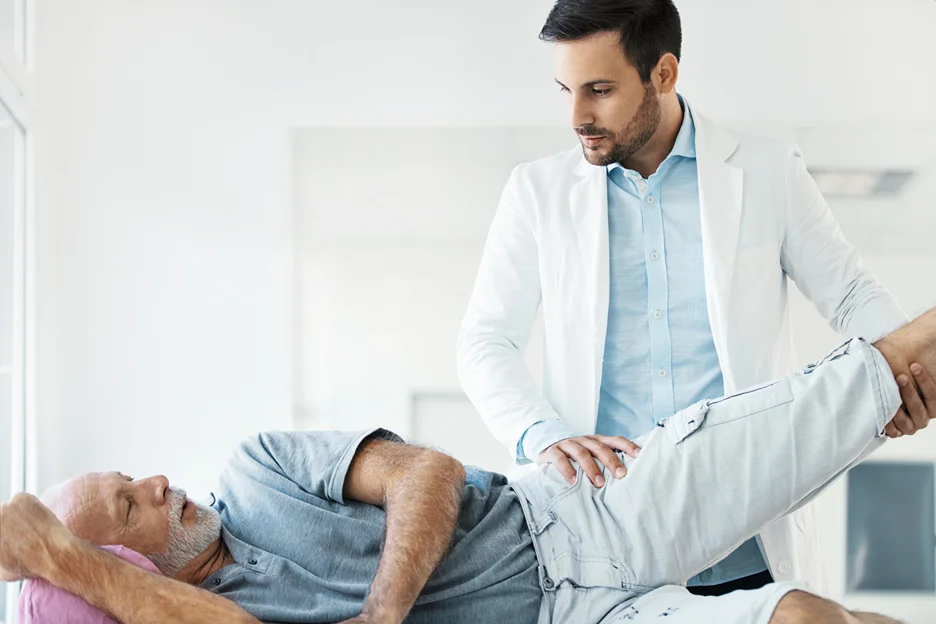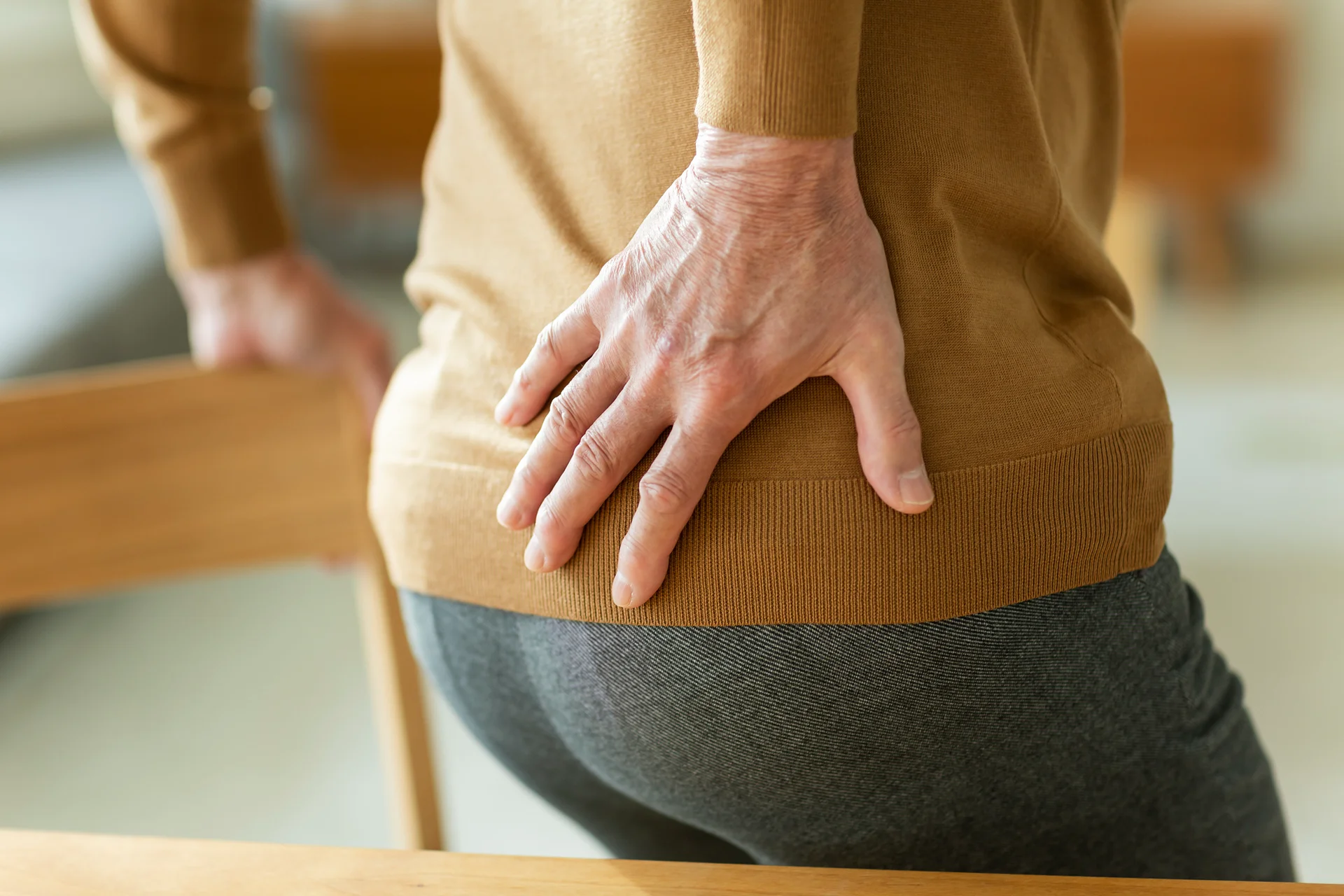Living with lower back and hip pain isolated to just one side of your body is no picnic. It’s like trying to make breakfast while only using your nondominant hand. Possible? Sure. Enjoyable? Absolutely not.
But the good news is, you don’t have to suffer indefinitely if you’re afflicted with this type of pain!
All the Potential Causes of One-Sided Lower Back and Hip Pain
When lower back and hip pain strikes only one side of your body, the asymmetry is a clear sign that something specific is amiss. The discomfort isn’t just general soreness from overuse or bad posture – it’s acute pain signaling an underlying medical issue.
Here are some of the most common conditions to blame for one-sided back and hip pain:
Sciatica
Sciatica describes pain, weakness, numbness, or tingling radiating from your lower back and hip down your leg, typically on just one side. It is caused by compression or inflammation of your sciatic nerve, which runs from your lower spine through your hip and butt down the back of each thigh.
This condition can make your lower back and hip ache, but it is most infamous for causing sensations of electric shocks, burning, throbbing, or stabbing that shoots down your leg on the affected side.
Herniated Disc
A herniated disc occurs when one of the rubbery cushions between your vertebrae ruptures and the jelly-like interior leaks out. If the protruding disc material presses on a nerve, it can cause severe pain that radiates down your leg. A herniation on one side of your spine is a prime suspect for unilateral back and hip pain.
Spinal Stenosis
This narrowing of the spinal canal puts pressure on the spinal cord and nerves, potentially affecting just one side. The resulting irritation often triggers pain, numbness, or weakness down the leg and into the hip.
Sacroiliac Joint Dysfunction
The sacroiliac joints connect your spine to your hip bones. If these joints move improperly or become inflamed, the ensuing asymmetry can cause isolated pain.
Piriformis Syndrome
The piriformis muscle runs from your sacrum to the top of your femur bone. If this muscle spasms or compresses the sciatic nerve, it may cause numbness and pain isolated to the affected side.
Arthritis
Osteoarthritis in your spine or hip joint breaks down protective cartilage, allowing bone to rub against bone. This erosion on just one side can make the corresponding areas of your back and hip extremely painful.
Pelvic Obliquity
Pelvic obliquity refers to one side of your pelvis being higher than the other side. This tilt in the alignment of your pelvic bones can put unequal pressure on your lower spine, hips, and legs. Pelvic obliquity can be caused by muscle imbalances, leg length differences, osteoarthritis, or scoliosis.
No matter which condition is causing your unilateral pain, the end result is an area of localized intense discomfort and weakness that can severely interfere with your daily activities.
Warning Signs Your Pain Needs Immediate Medical Attention
While some degree of back and hip pain is par for the course as you age, certain red flags warrant urgent medical evaluation. Seek emergency care if your one-sided pain is accompanied by:
- Loss of bladder control
- Fever and chills
- Numbness in the saddle area
- Unexplained weight loss
- Trauma such as falling or a car accident
These symptoms may indicate a serious underlying issue requiring rapid treatment, like cauda equina syndrome, fracture, infection, or even cancer. Don’t try to tough it out if your pain is extreme or progresses rapidly – get seen right away.
How Do Doctors Determine What’s Causing Your One-Sided Pain?

To pinpoint why your back and hip pain is confined to one side, your doctor will gather key clues from:
- Medical History – The doctor will ask questions about your health history, specific symptoms, daily activities, and any past injuries or trauma. This helps them start ruling out or zeroing in on possible causes of your one-sided pain.
- Physical Exam – Your doctor will check for tenderness, reduced motion, weakness, or numbness in your back, hip, leg, and foot.
- Imaging – X-rays, CT scans, or MRIs create pictures of your spine and hip to spot problems with bones, joints, nerves, and soft tissues. Plain X-rays are usually the first imaging test done in most cases.
- Blood Tests – These can detect issues like infection or autoimmune arthritis. These also help rule out inflammatory, infectious, or other systemic causes in select cases.
- Electromyography – This records electrical activity in muscles to check if nerves are being compressed.
Armed with these objective findings, your physician can zero in on what’s driving your lopsided pain and develop an effective treatment plan.
Ways to Find Relief From One-Sided Back and Hip Agony
Treating the precise source of your pain is key for lasting relief. Here are some common options recommended for one-sided lower back and hip discomfort:
- Medications – Over-the-counter pain relievers like acetaminophen or NSAIDs reduce inflammation and discomfort so you can keep moving while the underlying condition heals. Muscle relaxants also relieve painful spasms.
- Cold and Heat – Ice packs constrict blood vessels to decrease swelling and inflammation. Heating pads boost circulation to loosen tight muscles and joints. Alternating cold and heat can relieve stiffness, achiness, and nerve irritation.
- Physical Therapy – Stretches, exercises, and modalities like ultrasound targeted at your back, hip, and leg improve flexibility, strengthen stabilizing muscles, and increase your range of motion. This takes the pressure off pinched nerves and facilitates healing.
- Spinal Injections – Steroid injections directly into spinal joints, nerves, or tissues reduce inflammation that may be contributing to one-sided pain. Some injections numb specific aggravated nerves.
- Surgery – If conservative treatments fail to provide relief, procedures like discectomy or laminectomy remove the disc or bone material pressing on nerves. Hip replacement can also alleviate arthritis pain.
- Lifestyle Changes – Low-impact activities like yoga, Pilates, and tai chi strengthen core muscles while improving posture and alignment to prevent flare-ups. Mindfulness meditation helps reduce muscle tension and perceived pain levels.
No one deserves to suffer through excruciating one-sided back and hip pain. While the exact source may be unclear at first, seeing a doctor to map out a treatment plan tailored to your specific condition offers the best hope for recovery.
With patience and perseverance, you can get back to pursuing all the active things you love, free from unilateral pain’s tyrannical rule over your body.
Don’t Let Back and Hip Pain Take Over Your Life – Take Charge with Kaly

Living with chronic back and hip pain doesn’t have to mean endless doctor visits or constant medication adjustments.
Doctors will listen closely, provide an expert second opinion, order tests if needed, and recommend specialized referrals to finally find solutions.
No more guessing games with your care – Kaly uses state-of-the-art telehealth technology to connect you with compassionate pain management professionals who can help you take back control.
Schedule a telemedicine visit with Kaly today and start getting the answers and relief you deserve!
